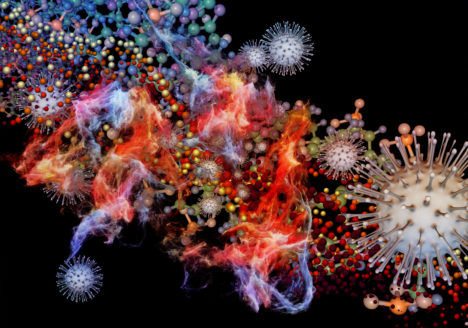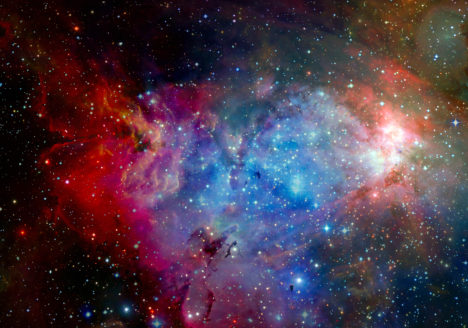How will the world’s oceans react to the warmer climate? This is just one of the many questions that can be addressed by building digital versions of the oceans.
We all know that the world is on route for a global warming of at least two degrees Celsius. However, this often-repeated figure is an average across the entire planet. Some locations will hardly see any difference, while others will really feel the heat has been turned on. The number one reason for the uneven distribution of the heat lies in the Big Blue – the world’s oceans.
Huge ocean currents not only move massive amounts of water around, but also redistribute the heat received from the sun. In some places, the major currents have a cooling effect – possibly mitigating the effect of global warming – while other places they will enhance the warming.
Furthermore, we can expect that the distribution of the additional heat will not follow the same patterns that govern the ocean circulation today. In fact, it is likely that, as temperatures pass certain thresholds, some currents will vanish or reverse direction.
“The ocean is opaque to light and radio waves and most of what we know about it was wrestled from its abyssal depths in month-long expeditions, braving hurricanes and icebergs.”
Building a silicon ocean
In principle, we could view global warming as a full-scale experiment, and just wait to see how things unfold. This approach is definitely not recommendable. Consequences in terms of natural disasters – floods, droughts, hurricanes etc. – are potentially huge, just like changed conditions for agriculture and fisheries will leave humankind to starve unless timely adjustments are found.
But how can we try and predict what will happen as the globe heats up over the coming decades? The ocean is opaque to light and radio waves and for a long time, most of what we know about it was wrestled from its abyssal depths in month-long expeditions, braving hurricanes and icebergs. Unfortunately, the types of information obtained in this way did not easily translate into a description of the overall circulation governing the ocean currents.
However, by the late 1990’ies affordable large-scale computing entered the scene. By now, we are able to do numerical simulations which realistically represent ocean physics and dynamics: we can build a “digital twin” of the ocean, which can then be used to study what happens if the ocean warms or
becomes more acidic?
Interaction at different length scales
As a science, physical oceanography faces two fundamental challenges: the turbulence closure problem, and complexity. The former refers to the fact that the structure of the largest currents depends sensitively on the properties of turbulence on the millimeter scale. The latter results from the interaction of processes on the same scale; for example, the Kuroshio – the Pacific’s equivalent of the Gulf Stream – has two different states, and each state can be maintained for several years in a row.

Above is an illustration of a NBI contribution to solving the turbulence closure problem.
Obviously, a digital ocean does not only interest climate scientists. We will now be able to study a range of features which we previously could only poorly quantify, or maybe did not even know of, like abyssal storms, rogue waves or maelstroms. Not to mention the vast consequences for fisheries which almost any changes in the ocean will have.
As in the atmosphere, much of the heat in the ocean is not transported by currents or jets, but by storms or turbulence. The picture shows the instantaneous surface speed of the ocean in the NBI ocean model. Bright wiggles are ocean storms. These storms are most prominent around Antarctica, and it turns out that these storms contribute to the rapid melting of the Antarctic ice sheet from below.
The simulations of TeamOcean at NBI have finally allowed to determine the strength of these storms as a function of Earth’s climate (Poulsen et al 2018), and the storms’ contribution to ice sheet melt.
In the model, the ocean is represented by 100,000,000 points. The simulations required continuous use for two years of 5,000 processors of one of the world’s biggest supercomputers. A new generation of models is being developed. They will be 100 times larger. It will require the brightest minds of this generation to develop an analytical framework that combines the output from these models with the theoretical framework of turbulence and fluid dynamics.
For more information click the button below.
Other Digital Worlds developed at NBI
I FEEL I CAN BRING SOMETHING TO THE TABLE
Age matters little as the NBI researchers create digital versions of the physical world. Often it will be the students who are able to teach their experienced professors a trick or two.
Academia has always had a tradition for open exchange of ideas, including between faculty and students. In a field where being born digital is a definite plus it can sometimes even be hard to tell who is teaching whom.
“One thing I did bring to the table was a new approach to testing various hypotheses against each other,” says Dion Häfner, PhD student in the ocean dynamics group at NBI.
The group creates digital twins of oceans (as explained in the Digital Oceans chapter), mimicking currents and other processes of the real oceans.
“Creating these digital twins is really challenging and interesting. However, what interests me even more is how we can put these models into work once we have them,” says Dion Häfner.
The computer does the boring work
Digital versions of the ocean can be utilized to obtain new knowledge by manipulating certain factors. What will for instance happen if the temperature increases or if a given current is weakened?
“The thing is, when we do this type of experiments and observe some results, different people will have different stories on what is going on in our complex climate system. Previously, people would just agree to disagree, but I don’t think we should settle for that. That’s why I am developing machine learning-based tools to test different hypotheses against each other in a principled, quantitative manner. This was a new approach to the group,” explains Dion Häfner.

Asked what attracted him to the field, he replies:
“Right from the outset I liked the idea that I am able to leave a lot of the boring work to the computer. Just pushing a button and waiting for results to come in is really satisfying. Meanwhile, I can focus on what I find interesting.”
A deep connection with nature
“Running an ocean model can almost feel like playing a computer game,” Dion says with a smile, then adding on a serious note:
“But of course, this is not a game. What we create in our computers reflects what takes place in the outside world every day. As humankind we are only able to spend a limited time on this planet. If we want to expand that time, we really need to understand the world around us.”
Sounds like you are motivated by mitigating climate change?
“In part, yes. Climate change is the most urgent challenge to us right now, but I am not only focused on that. Other changes in the Earth’s climate will come after this one, and we need to understand our planet to handle them. Actually, I would say that the study of nature itself is my main motivation. Also, I am really fascinated by the technical details behind being able to build something as complex as our world inside a computer.”
The computer is not the only way for Dion to study nature, he adds:
“I feel a deep connection with nature – as most natural scientists do. Ironically though, considering that technically I am an oceanographer, I am not much of a boat person. I would probably just get sea-sick.”
“As humankind we are only able to spend a limited time on this planet. If we want to expand that time, we really need to understand the world around us.”
Dion Häfner, PhD student in TeamOcean at NBI.




